Gravitational field:
In the case of non-contact force, the source mass and the test mass interact via a gravitational field. You can think of the gravitational force as a "command" and the gravitational field as a dialogue or speech used to give an order.
Gravitational field intensity
The strength of the gravitational field is called the gravitational field strength. This is the gravitational force acting on the unit mass.
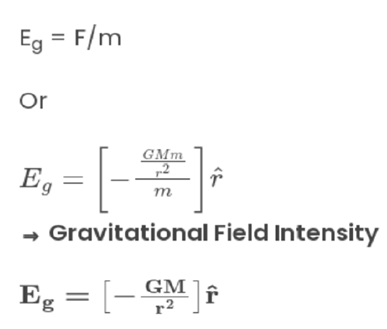
where r cap represents the position vector of the test mass from the source mass. The intensity of the gravitational field depends only on the mass of the source and the distance of a unit of thetest mass from the mass of the source.
The unit of gravitational field strength is N/kg.
The scale gives [M0L¹T–²]. The scale of gravitational field strength is identical to that of acceleration (from a gravitational perspective, we prefer to call it acceleration due to gravity).
The principle of superposition extends to the intensity of the gravitational field, for example
E = E1 + E2 + E3 + . . . . . . . + En
Thus, E1, E2, E3, . . . . . In are the gravitational field intensities at the point due to the nth particle of the system.
In the system, mass is always distributed in two different ways:
- Discrete mass distribution
- Continuous mass distribution
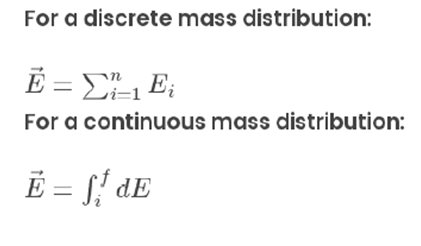
dE is the intensity of the gravitational fielddue to the main mass dm. The gravitational field formula is expressed as:
g = F/m
where, F = gravitational force and m = mass of the object.
Gravitational Field Intensity of a Point Mass:
Consider a point mass M, the gravitational force at a distance 'r' from it is given by the formula
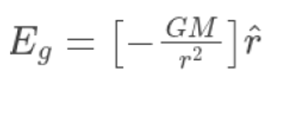
Gravitational Intensity of the Gravitational Field created by the Ring:
Consider a ring of mass M with radius 'a'; the gravitational field at a distance x along its axis is found as:
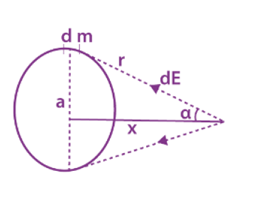
Gravitational field intensity
Consider a small element along the circumference of the ring with mass 'dm'; the field strength resulting from that length element is given by the formula,
dE = Gdm/r²
The vertical components of the fields cancel each other due to ring symmetry, and only the horizontal components are preserved and added.
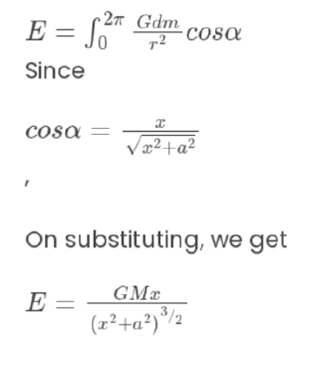
Gravitational field due to Uniform Spherical Shell:
Consider a thin uniform spherical shell in space of radius 'R' and mass 'M'. A 3D object divides space into three parts:
- Inside the spherical shell.
- On the surface of the spherical shell.
- Outside the spherical shell.
Our problem is to find out the value of gravitational field intensity in all these 3 regions
Outside the spherical shell
Consider a unit test mass at a point "P" at a distance "r" from the center of the spherical shell. Draw an imaginary spherical shell with point 'P' on its surface.
As we know, the gravitational field intensity at a point depends only on the mass of the sourceand the distance of the point from the mass of the source. We can say that the initial mass in the imaginary sphere is M and the separation distance is 'r'. That's what we get
E = -GM/r²
⇒ E ∝ -1/r²
On the surface of the spherical shell
Consider a unit test mass at a point "P" on the surface of the spherical shell at a distance "r" from the center of the spherical shell, where r = R. As mentioned above, the gravitational field intensity at the surface of the spherical shell is given by spherical shell
E = -GM/R²
Inside a spherical shell
If you consider a point inside a spherical shell, the entire mass of the shell is above the point. Draw an imaginary spherical shell around point 'P'; to leave this imaginary realm is zero.
We know that if the mass of the source iszero, the intensity of the gravitational fieldis alsozero.
∴ E = 0
Gravitational field due to a Uniform Solid Sphere:
Consider a uniform solid sphere of radius "R" and mass "M". Let's find the value of the gravitational field strength in all three regions:
- Within a solid sphere.
- On the surface of a solid sphere.
- Off a certain ball.
To find the gravitational field intensity at a point "P" at a distance "r" from the center outside the solid sphere, consider an imaginary sphere around P enclosing the entire mass "M".
∴ E = – GM/r²
⇒ E ∝ -1/r²
On the surface of a solid sphere
To find the gravitational field intensity at point "P" on the surface of a solid sphere,
Then E = -GM/R² ⇒ E = Constant.
Within a solid sphere
Find the gravitational effect at a point 'P' inside a uniform solid sphere at a distance 'r' from the center of the sphere. If we draw an imaginary sphere around this point, the mass of that imaginary sphere is given by 'm'.
For space (4/3) πR³, the existing massis M; forvolume (4/3) πr³ the existing massis "m".
Since the density of a solid sphere remains the same at all times,
m = M × (r³/R³)
Then the gravitational field intensity at point "P" inside the solid sphere at a distance "r" from the center of the sphere is given by:
E = -Gm/r²
Where m is the initial mass on an imaginary sphere drawn around point "P". Substituting the value of m in the above equation, we get
E = -GMr/R³
⇒ E ∝ -r
Gravitational potential energy - formulas, derivatives, solved problems
Gravitational potential energy is the energy that an object possesses or gains from its change inposition when it isin a gravitational field. Simply put, gravitational potential energy is the gravitational force or energy associated with gravity.
The most common example to help you understand the concept of gravitational potential energy is that you take two pencils, one of which is placed on a table and the other is held above the table. Now we can argue that a pencil in the air has more gravitational potential than a pencil on the table
Gravitational Potential Energy:
If a body of mass (m) is moved from infinity to a point under the gravitational influence of the initial mass (M) without accelerating it, the amount of work done in moving it to the initial field is stored in the form of potential energy. . . . This is called gravitational potential energy. It is denoted by the symbol Ug.

Explanation:
We know that the potential energy of a body at a particular location is defined as the energy stored in the body at that location. When the position of the body changes under the influence of external forces, the change in potential energy is equal to the amount of work done by the forces acting on the body. The work done by gravity does not depend on the path of change of position, so the force is a conservative force. All such forces also have a certain potential.
The effect of gravity on a body at infinity is zero; therefore, the potential energy is zero, called the reference point.
Gravitational Potential Energy Formula
The equation for gravitational potential energy is:
⇒ GPE = mgh
Where,
- m is the mass in kilograms
- g is the acceleration due to gravity (9.8 on earth)
- h is the height above the ground in metres
Derivation of Gravitational Potential Energy Equation:
Consider a source mass ‘M’ is placed at a point along the x-axis; initially, a test mass ‘m’ is at infinity. A small amount of work done in bringing it without acceleration through a very small distance (dx) is given by
dw = Fdx
Here, F is an attractive force, and the displacement is towards the negative x-axis direction, so F and dx are in the same direction. Then,
dw = (GMm/x2)dx
Integrating on both sides
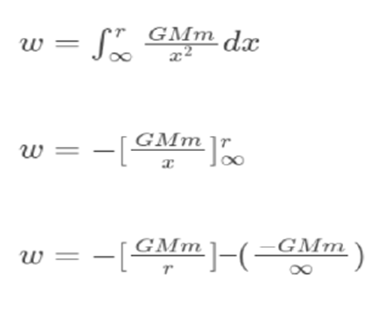
If ri> rf then ΔU is negative.
Since the work done is stored as its potential energy U, the gravitational potential energy at a point which is at a distance ‘r’ from the source mass is given by;
U = -GMm/r
If a test mass moves from a point inside the gravitational field to another point inside the same gravitational field of source mass, then the change in potential energy of the test mass is given by;
ΔU = GMm (1/ri – 1/rf)
If ri> rf then ΔU is negative.
Expression for Gravitational Potential Energy at Height (h) –
Derive ΔU = mgh.
If a body is taken from the surface of the earth to a point at a height ‘h’ above the surface of the earth, then ri = R and rf= R + h, then,
ΔU = GMm [1/R – 1/(R+h)]
ΔU = GMmh/R(R + h)
When h<
On substituting this in the above equation, we get,
Gravitational Potential Energy ΔU = mgh
Note:
The weight of a body in the center of the earth is zero because the value of g in the center of the earth is zero.
At a point in the gravitational field where the gravitational potential energy is zero, the gravitational field is zero.
What Is Gravitational Potential?
The amount of work done in moving a unit test mass from infinity into the gravitational influence of source mass is known as gravitational potential.
Simply, it is the gravitational potential energy possessed by a unit test mass.
⇒ V = U/m
⇒ V = -GM/r
⇒ Important Points:
The gravitational potential at a point is always negative, and V is maximum at infinity.The SI unit of gravitational potential is J/s
Relation between Gravitational Field Intensity and Gravitational Potential
Integral Form:
V = -
( If E is given and V has to be found using this formula)
Differential Form:
E = -dV/dr (If V is given and E has to be found using this formula)

(components along x, y, and z directions).
Gravitational Potential of a Point Mass
Consider a point mass M, the gravitational potential at a distance ‘r’ from it is given by;
V = – GM/r.
Gravitational Potential of a Spherical Shell
Consider a thin uniform spherical shell of the radius (R) and mass (M) situated in space. Now,
- Case 1: If point ‘P’ lies inside the spherical shell (r
As E = 0, V is a constant.
The value of gravitational potential is given by, V = -GM/R.
Case 2: If point ‘P’ lies on the surface of the spherical shell (r=R):
On the surface of the earth, E = -GM/R2.
Using the relation
- Case 1: If point ‘P’ lies inside the spherical shell (r
As E = 0, V is a constant.
The value of gravitational potential is given by, V = -GM/R.
- Case 2: If point ‘P’ lies on the surface of the spherical shell (r=R):
On the surface of the earth, E = -GM/R2.
Using the relation
over a limit of (0 to R), we get,
Gravitational Potential (V) = -GM/R.
- Case 3: If point ‘P’ lies outside the spherical shell (r>R):
Outside the spherical shell, E = -GM/r2.
Using the relation
V = -
over a limit of (0 to R), we get,
Gravitational Potential (V) = -GM/R.
Case 3: If point ‘P’ lies outside the spherical shell (r>R):
Outside the spherical shell, E = -GM/r2.
Using the relation
V = -
Gravitational Potential of a Uniform Solid Sphere:
Consider a thin, uniform solid sphere of radius (R) and mass (M) situated in space. Now,
- Case 1: If point ‘P’ lies inside the uniform solid sphere (r < R):
Inside the uniform solid sphere, E = -GMr/R3.
Using the relation
V = -
over a limit of (0 to r).
The value of gravitational potential is given by,
V = -GM [(3R2 – r2)/2R2]
- Case 2: If point ‘P’ lies on the surface of the uniform solid sphere ( r = R ):
On the surface of a uniform solid sphere, E = -GM/R2. Using the relation
V = -
over a limit of (0 to R) we get,
V = -GM/R.
- Case 3: If point ‘P’ lies outside the uniform solid sphere ( r> R):
Using the relation over a limit of (0 to r), we get, V = -GM/R.
- Case 4: Gravitational potential at the centre of the solid sphere is given by
V =(-3/2) × (GM/R).
Gravitational Self Energy
The gravitational self-energy of a body is defined as the work done by an external agent in assembling the body from the infinitesimal elements that are initially at an infinite distance apart.
Gravitational self-energy of a system of ‘n’ particles:
Let us consider n particle system in which particles interact with each other at an average distance ‘r’ due to their mutual gravitational attraction; there are n(n – 1)/2 such interactions, and the potential energy of the system is equal to the sum of the potential energy of all pairs of particles, i.e.,

Solved Problems
Example 1. Calculate the gravitational potential energy of a body of mass 10 kg and is 25 m above the ground.
Solution:
Given, Mass m = 10 Kg and Height h = 25 m
G.P.E is given as,
U = m × g × h = 10 Kg 9.8 m/s2 × 25 m = 2450 J.